If your clients fidget under harsh fluorescents, these 7 design shifts can cut session anxiety by up to 15%. Designing a therapy room isn’t just about matching colors or arranging furniture—it’s about creating an environment that quietly says, “You are safe here.” From the moment a client walks through the door, your space becomes part of the therapeutic relationship. Every detail—from lighting and sound to wall art and seating—can either enhance or interrupt a client’s sense of emotional safety.
In a profession rooted in connection, the design of your therapy office is more than aesthetics—it’s a tool for healing. Whether you’re starting from scratch or refreshing a room that no longer feels aligned, this guide will walk you through research-backed principles and practical strategies for transforming your therapy space into a calm, focused, and welcoming retreat.
You don’t need an interior design degree or a massive budget—just a clear understanding of what actually works. In this guide, you’ll learn how to apply calming therapy room design techniques that support your clients’ nervous systems, foster trust, and reflect your therapeutic presence.
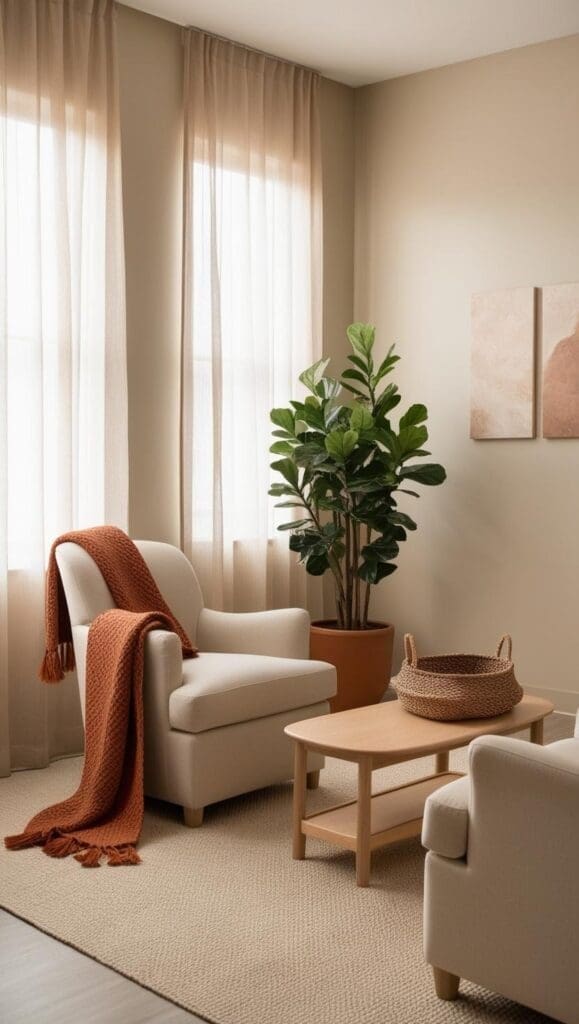
What You’ll Learn in This Guide
In this guide, you’ll learn how to:
- Apply proven calming therapy room design principles to increase client comfort
- Select the best lighting, furniture, and layout to promote focus and trust
- Use color and décor psychology for intentional emotional impact
- Complete a 7-day therapy office makeover with real tools and tips
Key Principles of Calming Therapy Office Design
Lighting: Layered, Natural, and Warm
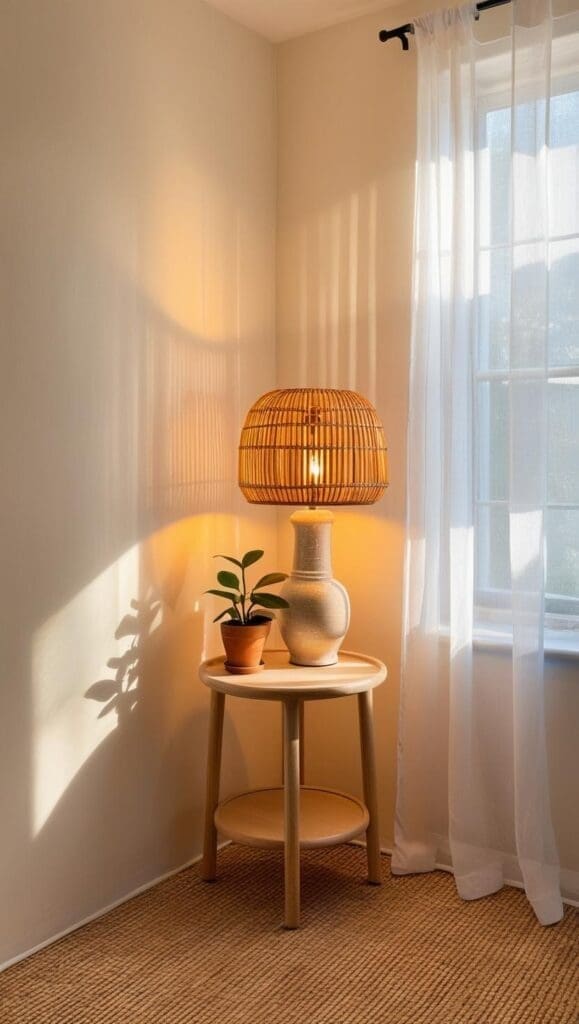
Lighting is foundational to mood regulation. Harsh overhead fluorescents can feel clinical or overstimulating—particularly for clients with sensory sensitivities, neurodivergent profiles, or trauma histories. Research supports what many therapists already notice intuitively: the quality of light affects how safe, focused, and regulated clients feel.
Whenever possible, maximize natural light using sheer curtains or diffusing shades. For artificial sources, opt for warm-toned bulbs between 2200K and 2700K, which closely mimic late-afternoon sunlight. This spectrum supports relaxation and a parasympathetic nervous system response, ideal for emotional processing and deeper therapeutic work (Veitch & Newsham, 2000).
In contrast, cool or fluorescent lighting (4000K–6500K) has been shown to increase alertness but may also trigger overstimulation, eye strain, or discomfort—especially in clients with autism, ADHD, or sensory processing challenges (Autism Research, 2017). Even imperceptible flicker from fluorescent lighting can exacerbate migraines or anxiety symptoms.
For maximum flexibility, layer light using dimmable floor lamps, table lamps, and rechargeable sconces, allowing you to adjust the mood of the room throughout the day.
- Maximize natural light with sheer curtains and light-diffusing shades
- Use warm bulbs (2200K–2700K) in floor and table lamps to create a safe, amber-toned atmosphere
- Install dimmers or opt for cordless, rechargeable lamps for flexible layering
Therapist tip: Warmer light helps downregulate the nervous system and improve emotional regulation. Cooler light (4000K+) is better reserved for task-specific zones like desks.
Color Palette & Décor Psychology
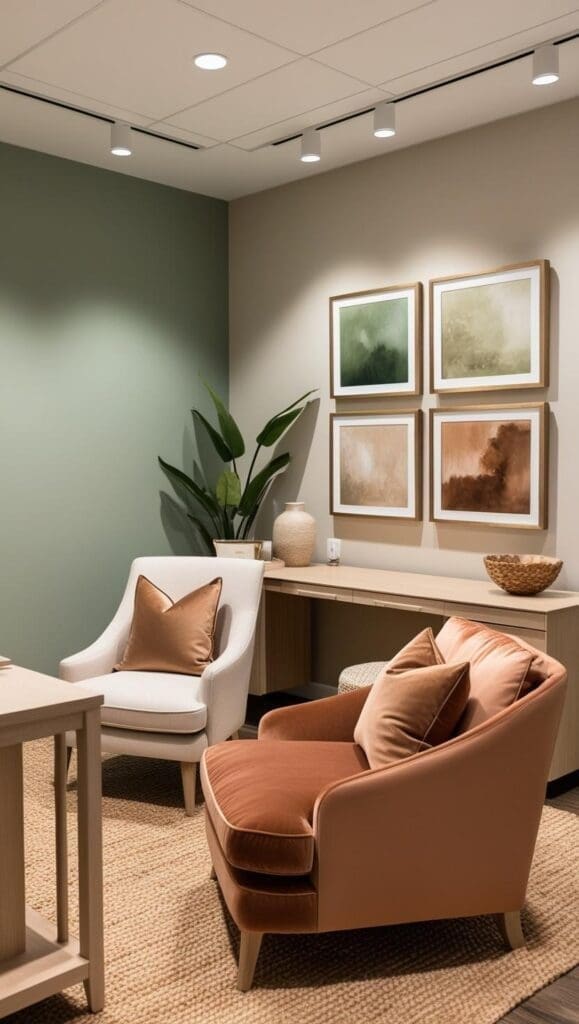
Choose colors with intention. Color can elicit strong emotional reactions and should align with your client population and therapy goals. Choose colors with intention. A growing body of research confirms that color impacts mood, perception, and emotional regulation, and should align with both your client population and therapeutic goals. Certain hues have been consistently associated with specific psychological responses, making them especially useful in therapy settings.
- Blue-green tones, such as sage or dusty teal, are among the most calming on the spectrum. Studies in environmental psychology have shown that these hues can reduce physiological arousal, lower blood pressure, and support introspection and trust—making them ideal for trauma-informed or emotionally intense work (Kwallek et al., 1996).
- Earthy neutrals like clay, beige, sand, and soft terracotta offer a grounded, natural feel. Rooted in biophilic design principles, these colors mimic organic environments and help reduce stress by activating calming pathways in the brain associated with safety and familiarity (Joye & van den Berg, 2011).
- Bright white walls and stark contrast (such as black-and-white palettes) may feel clean and modern but are often reported as overstimulating or sterile in therapeutic environments. White also reflects more light, which can increase eye fatigue and sensory discomfort over time—especially under overhead lighting (Wilkins et al., 2007).
Beyond color, soft textures play a sensory role in creating emotional comfort. Touchable, inviting materials like linen drapes, velvet pillows, and woven throws activate the parasympathetic nervous system and can be especially soothing for clients who struggle with anxiety or hyperarousal (Field, 2010). Incorporating symbolic or meaningful art—such as abstract landscapes or gentle affirmations—adds a layer of visual calm while also allowing the space to feel personal and safe.
- Blue-green tones support calm and introspection
- Earthy neutrals like beige, clay, and soft terracotta create grounding warmth
- Avoid bright white or harsh contrasts that can feel sterile or overstimulating
Incorporate soft textures (velvet pillows, linen drapes) and symbolic art to further soothe and ground the space.
Furniture & Layout Best Practices
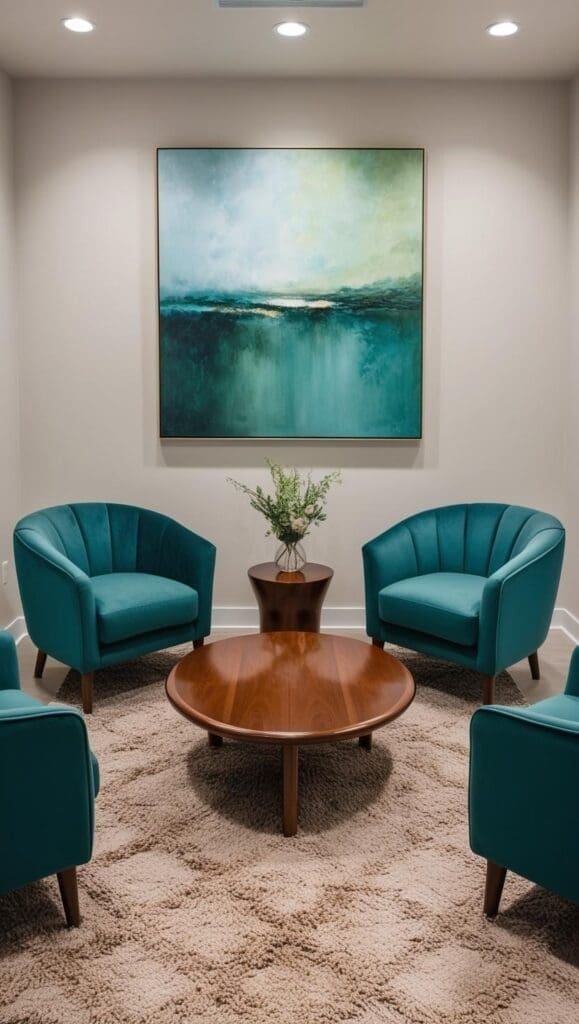
A thoughtful layout promotes safety and connection.
- Use rounded furniture to avoid visual harshness
- Create symmetrical layouts with seating that fosters open conversation
- Select the best therapy office furniture: ergonomic, non-squeaky, and sized to fit your space without crowding
Acoustics & Sound Management

Noise matters—both what you hear and what you don’t.
- Use thick rugs, drapes, and acoustic panels to reduce echo
- Play soft ambient music or white noise to reduce hallway sounds
- Add door draft stoppers or weather strips to limit disruptions
Biophilic Design & Air Quality
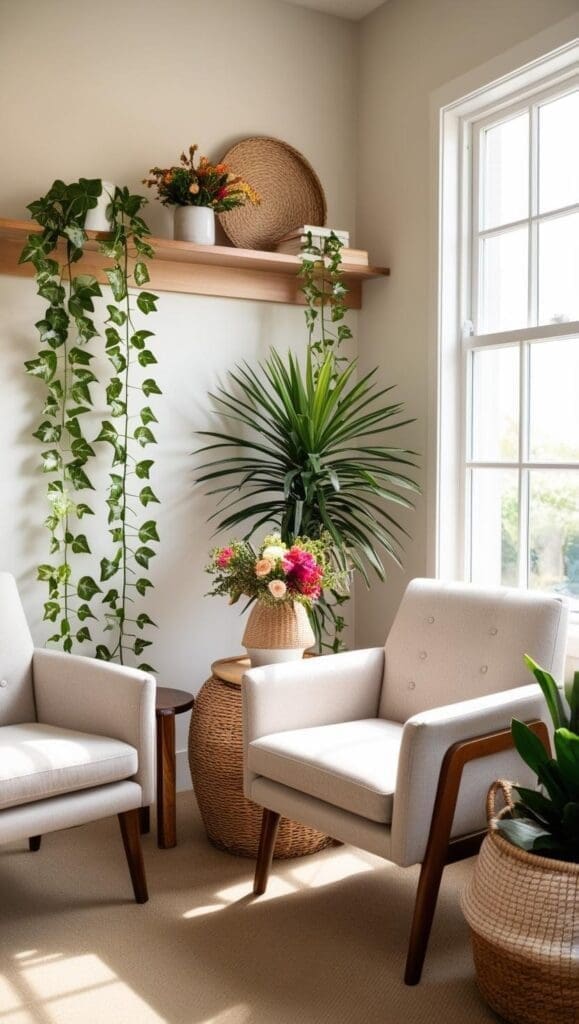
Biophilic therapy office design is based on our innate connection to nature. This includes:
- Houseplants like snake plants, peace lilies, or parlor palms
- Natural materials: wood, clay, cotton, wool
- Air purifiers or open windows for fresh air exchange
These elements reduce stress and improve both client and practitioner well-being.
Furniture & Décor Deep-Dives

To expand on these essentials, explore our in-depth guides:
10 Cozy Therapy Office Ideas That Feel Like Home
- Warm lighting, layered textures, and meaningful accents
The Best Desks for Therapists
- Small-space options, adjustable height desks, and storage tips
The Best Sofas for Therapy Offices
- How to pick durable, cozy, client-friendly couches
Decluttering: A Minimalist Approach
- Therapy office organization tips that support focus and flow
Budget-Friendly Decor Hacks
- DIY art, secondhand finds, and low-cost layout upgrades
Seasonal Decor Tweaks (Spring/Summer)
- Light refreshes that celebrate renewal and comfort
7-Day Step-by-Step Therapy Office Makeover Plan
You don’t need a full renovation to make your therapy space feel new. Follow this manageable week-long plan.
Day 1: Define Your Mood Board
- Choose 2–3 colors, one design theme (boho, minimalist, earthy)
- Use Pinterest or Canva to visualize textures and tones
Day 2: Declutter and Purge
- Remove unused or broken items
- Organize client materials into closed storage
Day 3: Rework Layout and Seating
- Pull furniture away from walls
- Use symmetry and clear paths to reduce overwhelm
Day 4: Adjust Lighting
- Swap in warm-toned bulbs
- Add floor or table lamps to dark corners
Day 5: Introduce Nature
- Buy or rotate in 2–3 houseplants
- Consider air-purifying or low-light species
Day 6: Update Art and Textiles
- Hang calming prints or therapist-created Redbubble art
- Add a new throw blanket or textured cushion
Day 7: Final Touches and Scents
- Tidy cords, add aromatherapy diffusers or fresh-cut herbs
- Take before/after photos and celebrate the shift
Dos & Don’ts of Calming Therapy Room Design
Do:
- Use soft, natural materials
- Prioritize function and accessibility
- Add personal but professional décor
Don’t:
- Overcrowd your space with furniture
- Choose lighting that’s too cool or too dim
- Ignore how sound travels through your office
Further Resources & Next Steps
Explore trusted resources to guide your design with client care in mind:
- American Psychological Association – Office Design Tips
- Mental Health America – Creating Healing Spaces
- Center for Health Design – Evidence-Based Design
Related Posts:
- How to Use Wallpaper for Therapy Office Decor: Embracing the Dark Aesthetic
- Boho Chic Office Decor Style: Creating a Free-Spirited Workspace Ideas to Refresh Your Practice
- The Best Sofas for Therapy Offices: Comfort, Style, and Function in One Elegant Piece
Create a Space That Supports Healing
Your office isn’t just where you work—it’s where transformation begins. A well-designed therapy room supports focus, trust, and emotional safety. Whether you’re aiming for minimalist calm or cozy warmth, these design strategies will help you shape an office that feels just right.
References:
- Veitch, J. A., & Newsham, G. R. (2000). Lighting quality and office work: A field simulation study. Journal of Environmental Psychology, 20(2), 147–164.
- Dain, S. J., & Lewis, E. (2017). Sensory discomfort and visual sensitivity under fluorescent lighting in individuals with autism spectrum disorder. Autism Research, 10(5), 842–853.
- Chellappa, S. L., et al. (2019). The influence of light on brain activity, alertness and circadian rhythms. Nature Reviews Neuroscience, 20(2), 73–85.
- Kwallek, N., Lewis, C. M., Lin-Hsiao, J. W., & Woodson, H. (1996). Effects of nine monochromatic office interior colors on clerical tasks and worker mood. Color Research & Application, 21(6), 448–458.
- Joye, Y., & van den Berg, A. E. (2011). Is love for green in our genes? A critical analysis of evolutionary assumptions in restorative environments research. Urban Forestry & Urban Greening, 10(4), 261–268.
- Wilkins, A. J., Veitch, J. A., & Lehman, B. (2007). LED lighting flicker and its impact on health. Clinical and Experimental Optometry, 90(4), 235–245.
- Field, T. (2010). Touch for socioemotional and physical well-being: A review. Developmental Review, 30(4), 367–383.
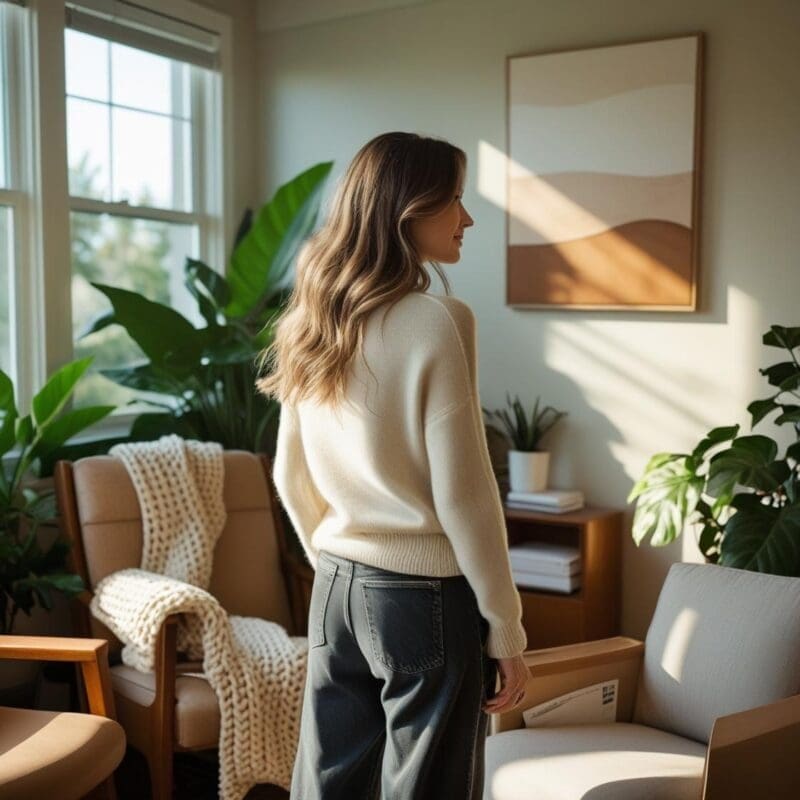
About the Author
Hi, I’m Eve, a former school counselor with a master’s degree in School Psychology and a passionate advocate for children and families navigating sensory challenges. As a mom of children with sensory sensitivities, I deeply understand the journey special-needs parents face, and I dedicate myself to researching and sharing practical solutions to help children thrive and feel comfortable in their bodies. My goal is also to empower counselors, therapists, and psychologists with creative strategies and supportive resources to enrich their everyday practice. When I’m not writing or exploring new therapeutic approaches, you’ll find me spending quality time with my family and continually seeking inspiration from everyday moments.

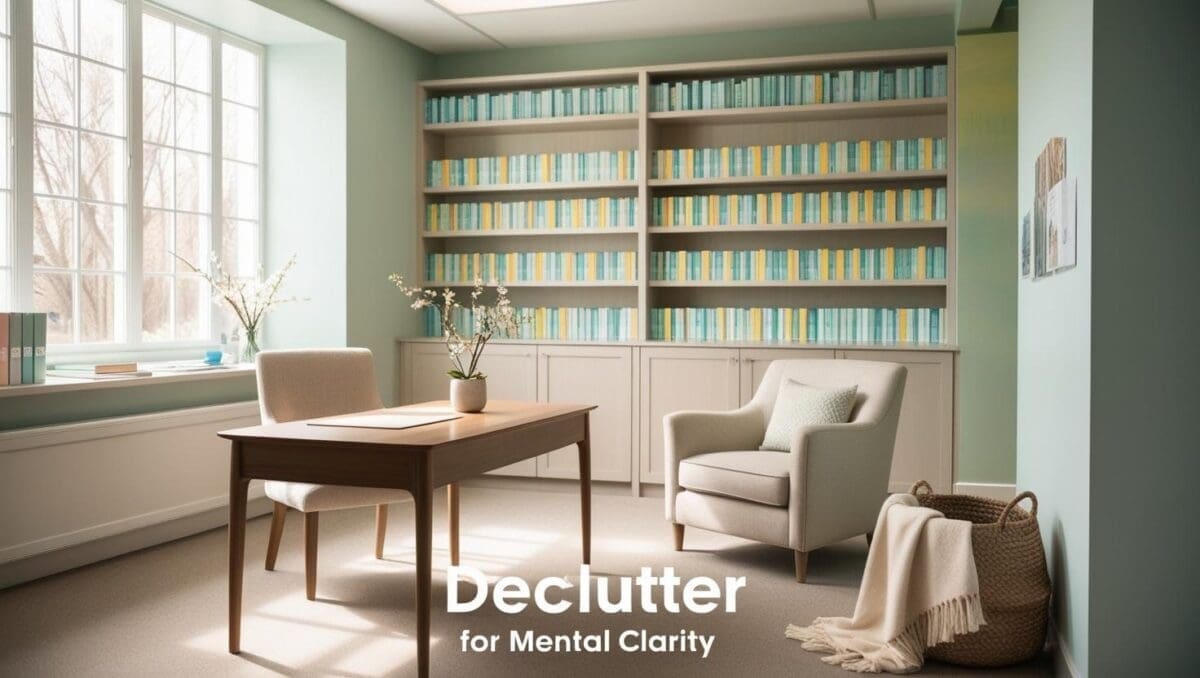

Pingback: How to Use Wallpaper for Therapy Office Decor: Embracing the Dark Aesthetic - EveYou
Pingback: Boho Chic Office Decor Style: Creating a Free-Spirited Workspace - EveYou
Pingback: 5 Budget-Friendly Ways to Upgrade Your Counseling Office Decor - EveYou
Pingback: Therapy Room Ideas: Bring Spring Indoors with These Calming Decor Tips - EveYou
Pingback: 10 Cozy Therapy Office Ideas That Feel Like Home - EveYou
Pingback: The Best Desks for Therapists: Functional, Beautiful, and Built for Calm Workspaces - EveYou
Pingback: The Best Sofas for Therapy Offices: Comfort, Style, and Function in One Elegant Piece - EveYou
Pingback: Declutter Therapy Office: Minimalist Steps for a Calm Space